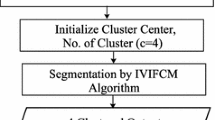Abstract
Image segmentation is one of the significant computational applications of the biomedical field. Automated computational methodologies are highly preferred for medical image segmentation since these techniques are immune to human perception error. Artificial intelligence (AI)-based techniques are often used for this process since they are superior to other automated techniques in terms of accuracy and convergence time period. Fuzzy systems hold a significant position among the AI techniques because of their high accuracy. Even though these systems are exceptionally accurate, the time period required for convergence is exceedingly high. In this work, a novel distance metric-based fuzzy C-means (FCM) algorithm is proposed to tackle the low-convergence-rate problem of the conventional fuzzy systems. This modified approach involves the concept of distance-based dimensionality reduction of the input vector space that substantially reduces the iterative time period of the conventional FCM algorithm. The effectiveness of the modified FCM algorithm is explored in the context of magnetic resonance brain tumor image segmentation. Experimental results show promising results for the proposed approach in terms of convergence time period and segmentation efficiency. Thus, this algorithm proves to be highly feasible for time-oriented real-time applications.



Similar content being viewed by others
References
Fuping Z, Jie T (2003) Modified fast marching and level set method for medical image segmentation. J Xray Sci Technol 11:193–204
Bazin PL, Dzung LP (2007) Topology preserving tissue classification of magnetic resonance brain images. IEEE Trans Med Imaging 26(4):487–496
Moussaoui A (2006) A neuro fuzzy image segmentation algorithm. Int J Soft Comput 1(3):232–238
Corso JJ et al (2008) Efficient multilevel brain tumor segmentation with integrated Bayesian model classification. IEEE Trans Med Imaging 27(5):1–7
Alirezaie J, Jernigan ME, Nahmias C (1997) Neural network based segmentation of magnetic resonance images of the brain. IEEE Trans Nucl Sci 44(2):194–198
Cristerna R, Medina-Banuelos V, Yanez-Suarez O (2004) Coupling od radial basis network and active contour model for multispectral brain MRI segmentation. IEEE Trans Biomed Eng 51(3):459–470
Willem M, Ron W, Lutgarde B (2006) Supervised Kohonen networks for classification problems. Chemom Intell Lab Syst 83:99–113
Sylvain C, Mounir B (2006) A bidirectional hetroassociative memory for binary and grey-level patterns. IEEE Trans Neural Netw 17(2):385–396
Cheng TW, Dmitry BG, Lawrence OH (1998) Fast fuzzy clustering. Fuzzy Sets Syst 93(1):49–56
Dzung LP, Jerry LP (1999) An adaptive fuzzy C-means algorithm for image segmentation in the presence of intensity inhomogeneties. Pattern Recogn Lett 20(1):57–68
Khalighi MM, Soltanian-Zadeh H, Lucas C (2002) Unsupervised MRI segmentation with spatial connectivity. International symposium on medical imaging, pp 1–9
Kolen JF, Hutcheson T (2002) Reducing the time complexity of the fuzzy C-means algorithm. IEEE Trans Fuzzy Syst 10(2):263–267
Liew AW, Yan H (2003) An adaptive spatial clustering algorithm for 3D MR image segmentation. IEEE Trans Med Imaging 22(9):1063–1075
Eschrich S, Ke J, Lawrence OH, Dmitry BG (2003) Fast accurate fuzzy clustering through data reduction. IEEE Trans Fuzzy Syst 11(2):262–270
Juang C, Shih-Hsuan C, Chang S (2007) A self organizing TS-type fuzzy network with support vector learning and its application to classification problems. IEEE Trans Fuzzy Syst 15(5):998–1008
Yong Y, Huang S (2006) Novel statistical approach for segmentation of brain magnetic resonance imaging using an improved expectation maximization algorithm. Opt Appl 36(1):125–136
Murugavalli S, Rajamani V (2006) A high speed parallel fuzzy C-mean algorithm for brain tumor segmentation. Bioinform Med Eng J 6(1):29–34
Liew AW, Yan H (2006) Current methods in the automatic tissue segmentation of 3D magnetic resonance brain images. Curr Med Imaging Rev 2(1):1–13
Nandedkar AV, Biswas PK (2007) A general reflex fuzzy min-max neural network. Eng Lett 14(1):1–11
Xiao K, Ho SH, Bargiela A (2010) Automatic brain MRI segmentation scheme based on feature weighting factors selection on fuzzy C-means clustering algorithms with Gaussian smoothing. Int J Comput Intell Bioinform Syst Biol 1(3):316–331
Haralick RM (1979) Statistical and structural approaches to texture. IEEE Trans Syst Man Cybern 67:786–804
Kim TY et al (2006) Cell nuclei image classification using 3-D texture features. 8th international conference on e-health networking, applications and services, pp 127–131
Xuan X et al (2007) Statistical structure analysis in MRI brain tumor segmentation. Int Conf Image Gr 22:421–426
Yang Y et al (2005) Fuzzy C-means clustering algorithm with a novel penalty term for image segmentation. Opto Electron Rev 13(4):309–315
MATLAB, User’s Guide, The Math Works, Inc., Natick, MA 01760, 1994–2002. http://www.mathworks.com
Acknowledgments
The authors wish to thank Dr. S. Alagappan of M/s. Devaki Scan Center, Madurai, Tamilnadu, India, for his help regarding MRI data and validation.
Author information
Authors and Affiliations
Corresponding author
Rights and permissions
About this article
Cite this article
Hemanth, D.J., Vijila, C.K.S., Selvakumar, A.I. et al. Distance metric-based time-efficient fuzzy algorithm for abnormal magnetic resonance brain image segmentation. Neural Comput & Applic 22, 1013–1022 (2013). https://doi.org/10.1007/s00521-011-0792-2
Received:
Accepted:
Published:
Issue Date:
DOI: https://doi.org/10.1007/s00521-011-0792-2




